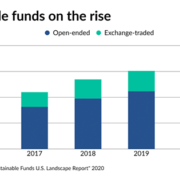[ Kiplinger ] SRI and ESG are Not Interchangeable. Here’s Why We Choose SRI.
If you’ve been reading the news lately, you’ve likely heard a lot about ESG (Environmental, Social, Governance) and/or SRI (Sustainable, Responsible and Impact) investing. While the terms are commonly used interchangeably, there are stark differences between the two that every investor should be aware of.
SRI
Back when I founded my firm in 2004, SRI was called socially responsible investing – now it is sustainable, responsible and impact investing. Same idea but different terminology and more rigorous vetting. The qualitative strategy that SRI typically uses filters to select positive, solutions-based companies while screening out offenders, such as fossil fuel, weapons or tobacco companies.
It also incorporates the concept of shareholder advocacy – using the proxy process to engage with companies to be, among other things, better corporate citizens, more transparent and focused on risks, such as climate change. We’ve seen shareholder proposals focused on corporate political activity, board diversity and a range of environmental issues, including palm oil and pollution clean-up. Often, these proposals are withdrawn before a vote, because the company agreed to take steps to improve practices. This active engagement is an important aspect of SRI.
Another tool of SRI is divestment, which means selling an individual stock or economic sector, because of their negative impact and refusal to make change through engagement. Probably the biggest victory of the divestment strategy was the campaign to divest from companies doing business with the Apartheid government in South Africa in the 1970s and ’80s. Ultimately, as more and more investors chose this route, the government was forced to negotiate and eventually led to the dismantling of the system.
The biggest current divestment movement involves fossil fuel companies, but there are other movements, such as divesting from private prisons.
Unprecedented Growth
Since I founded my firm nearly 20 years ago, the SRI investing industry has seen unprecedented growth. According to the US SIF Trends Report, there was about $2 trillion in professionally managed responsibly in the U.S. in 2004. The latest report, released in November 2020, listed the assets at nearly $17 trillion, which is now equivalent to one in three professionally managed dollars in the United States.
Much of that growth is being led by millennials. According to Morgan Stanley’s Sustainable Signals report, 95% of millennials are interested in sustainable investing. It has also been found that most values-based investors have specific interests, including plastic reduction, climate change, circular economy and multicultural and gender diversity. And an overwhelming majority (85%) of millennials and the general population (71%) believe that it’s possible for their investment decisions to influence the amount of climate change caused by human activities.
Enter ESG
With that growth came the arrival of the quantitative strategy of ESG research and ratings. ESG research breaks down these three metrics (Environmental, Social and Governance) and assigns a score relative to either other companies in the sector or across the broad market. Human judgment in the process is minimal because it’s quantitative, not qualitative like SRI.
These ESG scores are used to create indexes and then mutual funds and ETFs. They have been wildly popular over the past few years and marketed heavily by the big investment shops. They are low cost and have little deviation from the standard benchmarks like the S&P 500.
Why SRI over ESG
From our experience, we have found that the ESG rating systems are imperfect. Without active human oversight, you will often find companies in the funds that should never be there – like Exxon Mobil, McDonald’s, Raytheon and DuPont. Holdings like these are unacceptable for investors who are looking to align their investments with their values – especially when you consider the investment preferences listed in the Morgan Stanley report. And even more unfortunate is that most people are trusting of big name “ESG” labels and aren’t empowered with the right questions to ask to ensure that what they are investing in is what they think it is.
ESG is simply a tool to help portfolio managers make informed decisions on which companies to buy and which to avoid. I do not believe it should be used to directly create investment portfolios.
ESG ratings can be gamed – for instance when a fossil fuel company attempts to increase their score, knowing they will never score high on “E” (Environment), they can increase charitable donations for “S” (Social) or add a woman or person of color to their board to increase “G” (Governance). But participating in deceptive “greenwashing” does not make the company sustainable or responsible. It just means it is another company hopping on the SRI investing bandwagon, taking advantage of the market opportunity, and making money from false advertising.
And more often than not, ESG simply makes the fund “less bad.” Instead, my firm prefers to focus on portfolios that incorporate positive, solutions-based companies and not a watered-down version of the S&P 500.
We truly believe there’s only one way to benchmark the future, and it’s not by looking at the past. SRI investing is about investigating each and every holding, thinking about the role it will play in a future you believe in, and asking yourself: What are the things that we need as a society going forward?
Originally published in Kiplinger.
Photography: Getty Images

 Getty
Getty



 ZUMA PRESS
ZUMA PRESS ZUMA PRESS
ZUMA PRESS